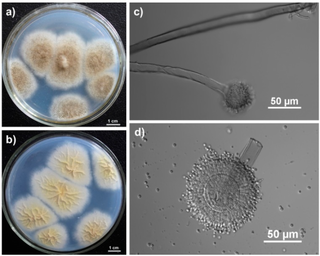
Penicillium chrysogenum is a species of fungus in the genus Penicillium. It is common in temperate and subtropical regions and can be found on salted food products, but it is mostly found in indoor environments, especially in damp or water-damaged buildings. It has been recognised as a species complex that includes P. notatum, P. meleagrinum, and P. cyaneofulvum, but molecular phylogeny established that it is a distinct species and that P. notatum is P. rubens. It has rarely been reported as a cause of human disease. It is the source of several β-lactam antibiotics, most significantly penicillin. Other secondary metabolites of P. chrysogenum include roquefortine C, meleagrin, chrysogine, 6-MSA YWA1/melanin, andrastatin A, fungisporin, secalonic acids, sorbicillin, and PR-toxin.
Penicillium austroafricanum is a fungus species of the genus of Penicillium
Penicillium contaminatum is a fungus species of the genus of Penicillium.
Penicillium crystallinum is a species of the genus of Penicillium.
Penicillium dierckxii is a species of the genus of Penicillium which produces citreoviridin and citrinin.
Penicillium dunedinense is a species of the genus of Penicillium which was isolated in Dunedin in New Zealand.
Penicillium formosanum is a species of the genus of Penicillium which produces patulin and asteltoxin.
Penicillium goetzii is a species of the genus of ascomycetous fungi.
Penicillium inflatum is an anamorph species of the genus of Penicillium which produces sterigmatocystin. It is from the Cremei section.
Penicillium nordicum is an anamorph species of fungus in the genus Penicillium which produces ochratoxin A. Penicillium nordicum contaminates protein rich foods and foods with high NaCl-konzentration. It is mostly found on dry-cured meat products and cheese products
Penicillium olsonii is an anamorph, filamentous species in the genus Penicillium which produces several polygalacturonases, xanthoepocin, asperphenamate, verrucolone, phthalate and olnacin. Penicillium olsonii is an often source of spoilage of tomatoes, salami and beans This species occurs ubiquitously in soil
Penicillium spathulatum is a species of fungus in the genus Penicillium which produces asperphenamate.

Aspergillus tubingensis is a darkly pigmented species of fungus in the genus Aspergillus section Nigri. It is often confused with Aspergillus niger due to their similar morphology and habitat. A. tubingensis is often involved in food spoilage of fruits and wheat, and industrial fermentation. This species is a rare agent of opportunistic infection.
Aspergillus astellatus is a species of the genus of Aspergillus. It is from the Nidulantes section. Aspergillus astellatus produces Aflatoxin B1, Aflatoxin B2 and sterigmatocystin.
Aspergillus xerophilus is a species of fungus in the genus Aspergillus. It is from the Aspergillus section. The species was first described in 1975. It has been reported to produce bisanthrons, dihydroauroglaucin, echinulins, erythroglaucin, isoechinulins, neoechinulins, physcion, sulochrin, and tetracyclic.
Aspergillus assulatus is a species of fungus in the genus Aspergillus. It is from the Fumigati section. The species was first described in 2014. It has been reported to produce indole alkaloids and apolar metabolites.
Aspergillus conicus is a xerophilic species of fungus in the genus Aspergillus which can cause endophthalmitis in rare cases. It was first described in 1914. It is from the section Restricti. Aspergillus conicus has been reported as a human pathogen.
Aspergillus shendaweii is a species of fungus in the genus Aspergillus. It is from the Fumigati section. Several fungi from this section produce heat-resistant ascospores, and the isolates from this section are frequently obtained from locations where natural fires have previously occurred. The species was first described in 2014.
Aspergillus solicola is a species of fungus in the genus Aspergillus. It is from the Fumigati section. Several fungi from this section produce heat-resistant ascospores, and the isolates from this section are frequently obtained from locations where natural fires have previously occurred. The species was first described in 2014. It has been reported to produce aszonalenins, chromanols, tryptoquivalines, tryptoquivalones, and wortmannins.

